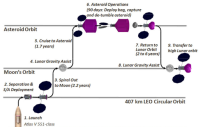SEC documents have revealed that the total development costs for Orbital Sciences’ Antares rocket have increased to $472 million, $184 million more than what NASA is paying them.
SEC documents have revealed that the total development costs for Orbital Sciences’ Antares rocket have increased to $472 million, $184 million more than what NASA is paying them.
That the company has been willing to commit these extra funds to develop Antares suggests to me that they see a commercial value for the rocket that will exceed these costs. Or to put it more bluntly, they see a market for their rocket that will pay for their investment, and then some.
SEC documents have revealed that the total development costs for Orbital Sciences’ Antares rocket have increased to $472 million, $184 million more than what NASA is paying them.
That the company has been willing to commit these extra funds to develop Antares suggests to me that they see a commercial value for the rocket that will exceed these costs. Or to put it more bluntly, they see a market for their rocket that will pay for their investment, and then some.

